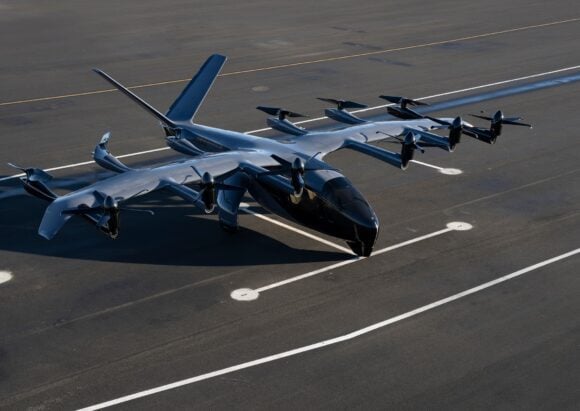
UAM Background 1 Oct
Airinsight-UAM caught up with Ken Stewart, CEO of GE’s platform for management of UAM operations, GE AirXOS. AiRXOS, part of GE Aviation, was launched in June 2018 as a new portfolio of autonomous solutions and partners to address the needs of autonomous transportation and the rapidly growing urban air mobility economy.
Ken’s more than 25-years of technology industry leadership, telecom expertise, start-up innovation, and executive management experience is well matched to run this leading-edge division of GE Aviation. Prior to AiRXOS Ken was Vice President, Sales and Business Development for Federated Wireless, responsible for strategic sales and partnerships. In previous roles he has held various Vice President leadership positions for GridPoint, Syniverse, NeuStar and MACH.
AirInsight: How did GE get into this part of the aviation industry?
Ken: AiRXOS is an example of how GE’s Business Creation team uses operational rigor to create businesses that are rooted in a shared purpose to help the world work better. AiRXOS aims to bring to market a number of autonomous technologies and infrastructure suitable for use in commercial air and ground robotics. GE saw a tremendous opportunity for a system that can address big problems like drone operations, corridor development and digitizing air traffic management. AiRXOS was one of only two companies that were actually created within GE Ventures, and was done so as a collaboration between GE Ventures and GE Aviation. We recognized early on that to develop the type of technology for the future of flight we’d need to bring together two disparate industries, traditional aerospace and Silicon Valley-minded software development. We needed to develop capabilities at start-up speeds with the rigor of aerospace safety and compliance. In the aviation space, this had never really been done before and has been key to some of our early success.
AirInsight: What are GE AiRXOS services and products?
Ken: As a company we focus on enabling advanced UAS Operations, for federal and state agencies and enterprise. Essentially any operation that is beyond Part 107 and require waivers and exemptions. Federal and state agencies and enterprises need repeatable, scalable, and economically viable solutions that can leverage the automation that UAVs provide. The combination of our Air Mobility Platform software solution and Waiver Services deliver on those outcomes.
There are three parts to AiRXOS’ portfolio:
- High-powered, cloud computing infrastructure that lets drone pilots visualize their airspace, including weather, other traffic, terrain like mountains or trees, or obstacles like cell towers
- Intelligent avionics, including high-performance edge computing necessary for drones to collect and use all the data they collect and to safely operate unmanned aircraft
- Services, including the regulatory and policy expertise to help both the FAA and drone operators operate safely, including corridor development and traffic management
AirInsight: What is the significance of participation in the FAA Unmanned Pilot Program (UPP) for AirXOS?
Ken: UAV-based services are a nascent and emerging market and these pilot programs help us to more rapidly evolve that ecosystem of technology and services that will open-up the drone economy. By bringing industry leaders into these programs – made up of private sector industries, state and federal agencies – we’re able to accelerate adoption of drone-based technologies and services integrated into the national airspace system. It’s a win for enterprises and the industry overall.
AirXOS participated in the real-world flight operations for the FAA’s first phase of the Unmanned Aircraft System (UAS) Traffic Management Pilot Program (UPP). The UPP, established in 2017, was designed to identify the initial set of industry and FAA capabilities required to support UAS Traffic Management (UTM) operations.
As a UAS Service Supplier (USS) for UTM, and after our successful participation in NASA’s related UTM demonstration programs over the last two years, AiRXOS was the only industry partner selected to participate on more than one FAA UAS test site for UPP. Throughout the UPP, AiRXOS was also the only USS to support internal and external flight operators while demonstrating live UTM operations through our Air Mobility™ platform at all sites and providing simulated UAS operations across all three programs.
AirInsight: How does GE AiRXOS enable Urban Air Mobility?
Ken: We see Unmanned Traffic Management (UTM) as a foundational element for Urban Air Mobility. AiRXOS, as a provider of UTM services and technologies, is collaborating with multiple government agencies, both local and federal, on the development of a UTM framework to include: Airspace policy, technologies, and processes to ensure the safe integration of UAVs and subsequently UAM into the national airspace. AiRXOS is the foundation for Urban Air Mobility.
AirInsight: What do you see as the outlook for UAM?
Ken: UAM is an emerging and innovative transportation option that will soon help to avoid the congestion plaguing many cities around the world. This includes people, cargo, and medical transport. Every week, we hear of new aircraft targeting UAM being introduced. The key for UAM to be successful will depend on three main areas:
- Private sector investment will need to continue to drive the development of this UAM ecosystem.
- Policy remains to be a barrier in the development of the UAV services market and will need to move faster in order to meet the needs of UAM
- Public support in two key areas: A) Financially, in that the economics must be better than or equitable to current modes of transportation, and B) Public trust in the safety of the operations of these aircraft.
AirInsight: What are some of the challenges that AiRXOS must overcome?
Ken: As we consider drones fly longer distances or over populated areas, we need to be able to collect and analyze a lot more data – both the data that the drone is acquiring for whatever task it is performing and to operate safely. For example, our system pulls together weather, traffic, and other information needed for safe navigation. Artificial intelligence helps us manage all of this data. We need higher powered computing on the drones themselves, and all of that data has to be transmitted to the cloud. Weather and other data also needs to be transmitted to the drones in real-time. This is a massive amount of data exchange and computing, but it is necessary if we are going to safely operate unmanned aircraft beyond the line of sight and with less human pilot intervention.
In terms of the industry there are issues around scale – the predicted density of drone traffic is more than current air traffic management systems can handle right now, communication – ATM systems work on voice communication with pilots and control towers, drones don’t have a an on-board pilot, and some drones don’t have any voice features. You also have radar issues – manned traffic uses radar to detect and avoid, radar presents an issue for unmanned traffic since drones fly too close to the ground for efficient use of radar. So a lot of challenges, which promises many opportunities.
AirInsight: What is the most exciting part of AirXOS for you personally?
Ken: I am excited that we can share what we are doing with more people. We were operating in stealth mode for a long time. Now we can let the world know that we are already in a strong position, thanks to our participation in the Department of Transportation pilot programs, our collaboration with the NUAIR alliance in New York, and our other projects and partnerships.
AirInsight: Thanks Ken for sharing you vision for AirXOS with Airinsight-UAM.
Views: 0




